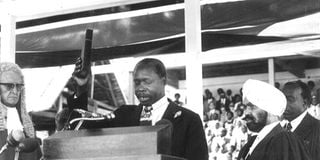Moi names Cabinet after first General Election under his rule

Daniel arap Moi being sworn in as Kenya's second president. The most striking feature of Moi's new Cabinet was the absence of seven senior ministers and 15 assistant ministers, who were closely associated with the Kenyatta regime. PHOTO|FILE.
What you need to know:
- In their 1998 book, Multi-Party Politics in Kenya, David Throup and Charles Hornsby argue that the most striking feature of the Cabinet was the absence of seven senior ministers and 15 assistant ministers, who were closely associated with the Kenyatta regime.
- Twelve new ministers joined the Cabinet as new dockets for Energy, Industry, Transport and Communications, and Environment and Natural Resources were created.
- Nyachae assumed control of the Cabinet Secretariat and had the president’s ear on matters of policy.
President Daniel arap Moi named an expanded Cabinet following the General Election.
Some 72 out of 158 MPs lost their seats in the first election in the president’s rule held on November 8.
In their 1998 book, Multi-Party Politics in Kenya, David Throup and Charles Hornsby argue that the most striking feature of the Cabinet was the absence of seven senior ministers and 15 assistant ministers, who were closely associated with the Kenyatta regime.
They were among those who lost in the elections.
The Cabinet was also larger. For instance, the Agriculture Ministry, which previously had two assistant ministers, now had two ministers and six assistant ministers.
Twelve new ministers joined the Cabinet as new dockets for Energy, Industry, Transport and Communications, and Environment and Natural Resources were created.
They were all headed by Moi’s cronies.
Henry Kosgey was in Energy while Jonathan arap Ng’eno became minister of Water Development.
“Their appointments came with the message that cooperation with the new regime would be rewarded,” Throup and Hornsby write.
The Kenyatta regime had ended a year before following his death on August 22, 1978.
Dr Robert Ouko had been brought by Kenyatta into his Cabinet in 1977 as minister for Economic Planning and Community Affairs.
After he won the Kisumu Rural seat in 1979, Moi appointed him to the Foreign Affairs docket.
President’s cronies
Throup and Hornsby argue that the candidates who were openly supported by Moi also won parliamentary seats.
For instance, Joseph Kamotho defeated Dr Julius Kiano in Kangema.
These were people who had supported Moi during the controversial 1976 change- the-constitution movement. Others included Godfrey Gitahi (GG) Kariuki, Charles Rubia, and Paul Ngei.
The aim of the movement had been to stop Moi from taking over from Kenyatta, who was ailing and many thought would die soon.
The movement was led by Gema members, such as Dr Njoroge Mungai, Njenga Karume, and Kihika Kimani.
Maximum efficiency
It died when Attorney-General Charles Njonjo warned that it was treasonable to imagine the death of a president.
In his speech before announcing the Cabinet, Moi noted that his government would be based on nation-building and restructuring to ensure maximum efficiency.
Three key figures in the Office of the President (OP) were Moi’s supporters: Simeon Nyachae was named PS for Development Coordination while Nicholas Biwott and G.G Kariuki were named ministers.
Historians argue that Nyachae was a man Moi could trust bccause the two were business partners.
In his 1991 book, African Successes, David Leonard argues that Nyachae assumed control of the Cabinet Secretariat and had the president’s ear on matters of policy.
Similarly, G.G Kariuki, in his book, The Illusion of Power: Reflections on Fifty Years in Kenyan Politics, admits that his appointment to the Cabinet was due to his close relationship with Moi, dating back to 1964, when the latter joined Kanu from Kadu.
Mwai Kibaki and Njonjo remained Vice-President and Minister of Finance and Attorney General, respectively.
The government ballooned, as Moi sought unity through the incorporation of every community and interest.
At least 35 per cent of the Cabinet appointees were Kikuyu and 10 percent Luo. The remaining 55 percentage comprised other tribes.
Elijah Mwangale entered Moi’s Cabinet as minister for Labour. He abandoned his radicalism and became an establishment figure.
The number of Kalenjins doubled from two to four, that is Moi, Biwott, Kosgey, and Ng’eno.




